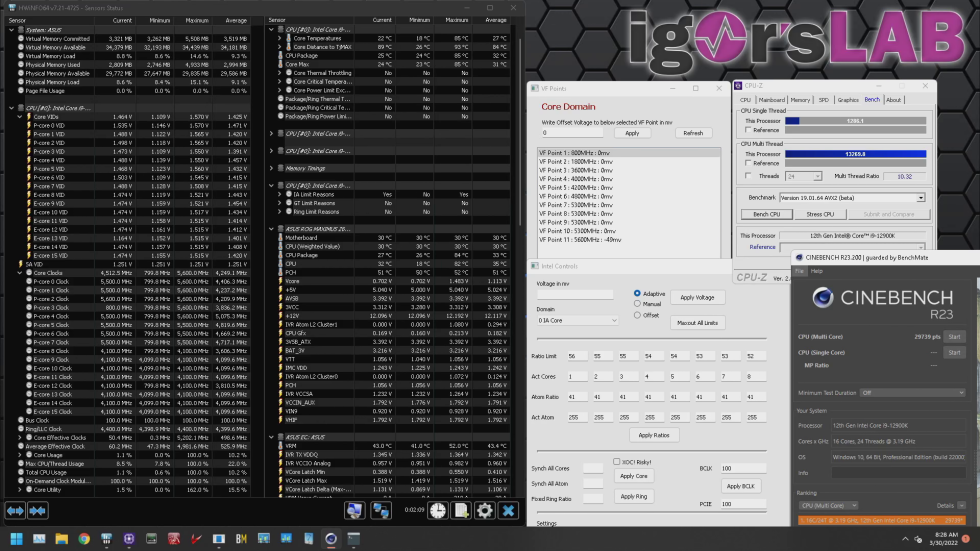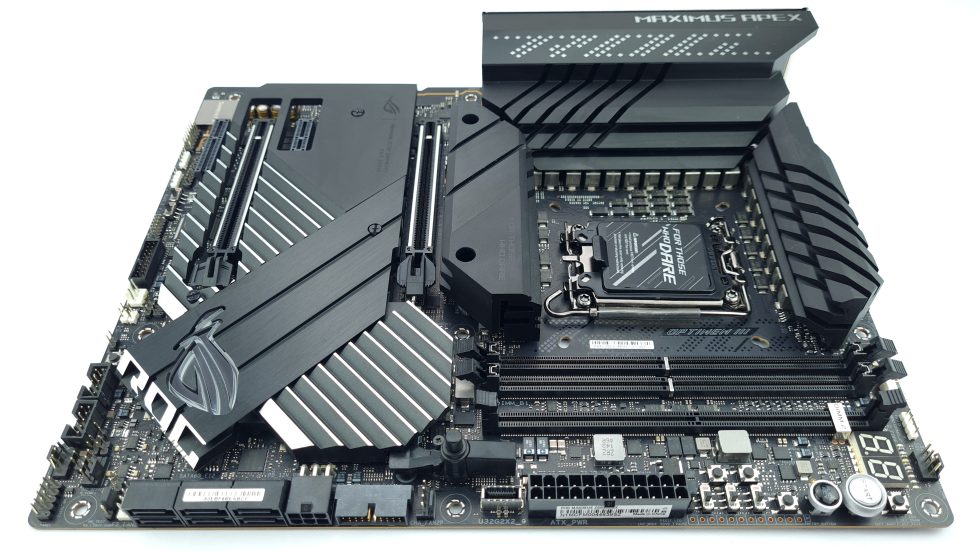Adaptive By-Core OC
Who would have thought that CPU overclocks would end up on the last page when testing an overclocking motherboard? However, that is by no means a bad thing, because the Z690 Apex does practically everything right here. Whether classic, static or per-core OC, whether with static or adaptive voltage, whether with e-cores or without, or whether with increased BCLK or without, everything works almost flawlessly.
As an example, I let my average i9-12900K CPU with conventional water cooling clock to 5.2 – 5.6 GHz on the P-cores, depending on the workload. The voltage is requested by the internal PCU depending on the situation and is effectively 1.2 – 1.45 V under load. The voltage curve can be easily optimized via the V/F points with offsets from within the OS using Tool.exe, and the multipliers depending on the load can also be changed on-the-fly in this way. For this I also use only LLC1, with 0.6 mOhm AC_LL and 1.75 DC_LL. The complete BIOS settings are still available here as a small BIOS tour:
Speaking of LLC, here Asus goes the tried-and-true route with their 8 levels and also takes over the actual resistance values from previous Maximus generations for the most part. With a maximum of 1.75 mOhm LLC, it is therefore possible to ensure high stability even with transients in the partial load range with minimum voltage. Contrary to the Intel specification, Asus disables the IA CEP (Intel Architecture Current Excursion Protection) by default, which has to be disabled for adaptive voltage undervolting. They probably anticipated the user frustration about performance throttling by IA CEP and proactively disabled the feature. For comparison, MSI strictly adheres to the Intel spec in the Unify-X, for example, so you have to deactivate IA CEP for an adaptive OC.
Asus goes its own way in many things, away from the Intel specification, like in the naming of the new DDR5 voltages. Thus, BCLK Adative Voltage can also be disabled in the BIOS of the Z690 Apex, a mechanism of the PCU that leads to too much requested voltage when overclocking with increased BCLK. It wasn’t until I missed exactly this feature in the recent review of the MSI Z690 Unify-X that I realized the value of Asus’ in-house developments. And it is precisely this “thinking outside the box” that makes features like the Non-K OC possible in the first place. Thus, my i3-12100F CPU can be run completely stable at over 5 GHz on all cores in Prime95 with AVX-512. Whether one considers these self-interpretations of Intel’s specifications to be technically correct is up to the user to decide.
Summary and conclusion
The Asus ROG Maximus Z690 Apex is a motherboard with many interesting facets overall and two glaring extremes in RAM-OC. While the older M0EAY0 board from 2021 can’t even run a DDR5-6400 kit from the QVL in the XMP, the new M0UAY1 specimen, which was also selected, manages a fabulous 7000 Mbps stably. The fact that the former is effectively a defect that justifies an RMA has already been stated at the beginning. But it still means a bad experience for the potential buyer.
For interest, I also sourced another Z690 Apex motherboard through regular retail, as I wanted to know what batch of motherboard a regular customer would get in March 2022. The sobering answer was a sample 1with part number M0EAY0 from November 2021 and also problems with my RAM in the XMP. Some contacts from various Discord servers have also recently entered the retail lottery for the Z690 Apex and unfortunately mostly received boards from the M0EAY0 batch. To be fair, not all of the M0EAY0 motherboards automatically violate the QVL and are therefore considered RMA-worthy. There are also good motherboards in these older batches, but according to user reports, the chances are much worse than in the M0UAY1 re-release from this year, which is said to have made it into the retail market from time to time.
For around 630 Euros you get a motherboard from Asus that offers more than almost any other Z690 platform in terms of feature set and CPU overclocking. The huge selection of BIOS options and software tools are a real delight for enthusiasts and hobbyists and optimal for getting to know the Alder Lake CPU generation with its various new peculiarities. However, a 2-DIMM board must also be able to perform RAM-OC well and reliably, and in any case better than a 4-DIMM alternative. Here the Z690 Apex will need a lot of luck during the purchase or a lot of patience afterwards when it comes to the RMA, which Asus at least grants without any problems. But when you finally manage to get your hands on a good Z690 Apex, you certainly don’t want to give it away.
As long as Asus does not find out the reason for the defective boards or recalls the affected boards, the Maximus Z690 Apex will remain an expensive overclocking gamble. Recently, there were also quality problems with the Z690 Hero (backwards mounted capacitor) and according to user reports, the 4-DIMM Maximus boards also suffer from strongly varying RAM-OC performance. All of this together suggests that Asus might have focused too much on the subtleties of the Z690 generation and lost sight of the essentials. Unfortunately, this is all conjecture for the time being.
The motherboard was kindly provided to us by ASUS without any obligation to publish it. In addition, there was no influence on the tests and their results.
ASUS ROG Maximus Z690 Apex (90MB18I0-M0EAY0)



































43 Antworten
Kommentar
Lade neue Kommentare
Veteran
Mitglied
Veteran
Veteran
Veteran
Mitglied
Veteran
Veteran
Urgestein
1
Veteran
Veteran
Veteran
Veteran
1
Mitglied
Urgestein
1
Mitglied
Alle Kommentare lesen unter igor´sLAB Community →